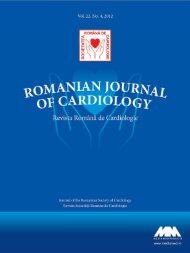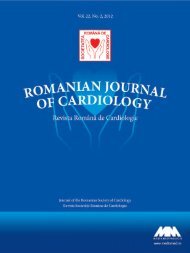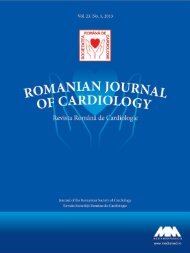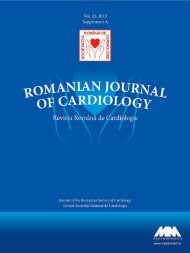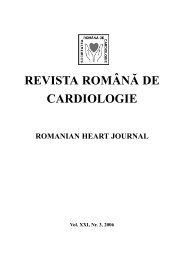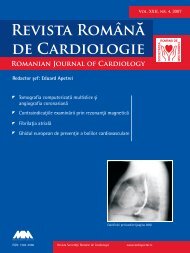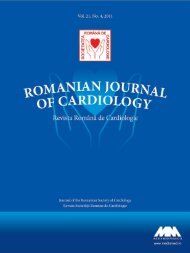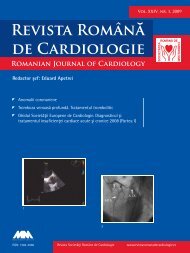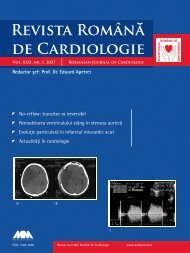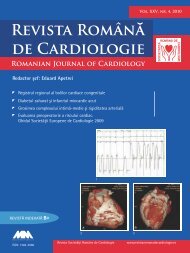Untitled - Romanian Journal of Cardiology
Untitled - Romanian Journal of Cardiology
Untitled - Romanian Journal of Cardiology
- No tags were found...
You also want an ePaper? Increase the reach of your titles
YUMPU automatically turns print PDFs into web optimized ePapers that Google loves.
<strong>Romanian</strong> <strong>Journal</strong> <strong>of</strong> <strong>Cardiology</strong> | Vol. 23, No. 2, 2013<br />
REVIEWS<br />
Chronic thromboembolic pulmonary hypertension,<br />
present update and future directions<br />
T. Constantinescu, M. Bogdan<br />
Article received on the 18 th <strong>of</strong> May 2013. Article accepted on the 27 th <strong>of</strong> May 2013.<br />
Abstract: Chronic thromboembolic pulmonary hypertension (CTEPH) represents a distinct category <strong>of</strong> pulmonary hypertension<br />
(PH), forming the 4 th group <strong>of</strong> the Dana Point PH Classification 2008. CTEPH is considered a rare complication <strong>of</strong><br />
pulmonary embolism (PE) but the incidence and prevalence are still unclear. Although the natural history <strong>of</strong> the disease is<br />
severe, more than 50% <strong>of</strong> the CTEPH patients may be cured by thrombendarterectomy. For the inoperable or persistent postoperatory<br />
CTEPH patients medical treatment with modern vasodilators used in pulmonary arterial hypertension (PAH) may<br />
represent a solution.<br />
CTEPH is characterized by a mechanical obstruction <strong>of</strong> the pulmonary arteries by organized thrombi. The disease is associated<br />
with a variable degree <strong>of</strong> vascular hypertensive remodelling <strong>of</strong> the pulmonary microcirculation, leading to an increase in<br />
pulmonary vascular resistance, pulmonary pressures and finally to progression towards right heart failure.<br />
The confirmation requires the evaluation in an experienced centre and should include an invasive hemodynamic pr<strong>of</strong>ile, as<br />
well as complex imaging investigations, such as scintigraphy, angioCT or MRI, for establishing the surgical indication, and, if<br />
required, preoperative conventional angiography.<br />
Presently, in Romania specific therapies are available for operable patients and also for inoperable patients, through the PAH<br />
National Program, with positive long term results.<br />
Keywords: chronic thromboembolic pulmonary hypertension, thrombendarterectomy, specific therapies<br />
Abstract: Hipertensiunea pulmonară cronică postembolică (HTPE) reprezintă o categorie distinctivă de hipertensiune pulmonară<br />
(HTP), formând grupul 4 al clasificării Dana Point 2008. HTPE este considerată a fi o complicație rară a tromboembolismului<br />
pulmonar (TEP) însă incidența și pre valența reale sunt încă neclare. Deși evoluția naturală a bolii este severă, peste<br />
50% din pacienți pot fi vindecați prin tromb endarterectomie. Pentru pacienții inoperabili sau cu HTP persistentă postoperatorie<br />
pot fi încercate terapiile vasodilatatoare utilizate în hipertensiunea arterială pulmonară (HTAP).<br />
HTPE se caracterizează prin obstrucția mecanică a arterelor pulmonare prin trombi organizați. Boala se asociază într-o pondere<br />
variabilă cu remodelarea hipertensivă a microcirculației pulmonare determinând creșterea rezistenței vasculare pulmonare,<br />
a presiunii în arterele pulmonare și progresia către insuficiență cardiacă dreaptă.<br />
Diagnosticul de certitudine necesită evaluarea într-un centru cu experiență și presupune atât bilanțul hemodinamic invaziv<br />
cât și evaluarea operabilității prin investigații imagistice complexe: scintigrafie, angioCT sau RMN iar preoperator, angio grafie<br />
convențională.<br />
In România există posibilități terapeutice atât pentru pacienții operabili cât și pentru cei ce necesită terapie vasodilatatoare<br />
pulmonară prin Program National, cu bune rezultate pe termen lung.<br />
Cuvinte cheie: Hipertensiune pulmonară cronică postembolică, trombendarterectomie, vasodilatatoare pulmonare.<br />
DEFINITION AND HISTORY<br />
The first observations, regarding a severe evolution <strong>of</strong><br />
patients with PH that associated obstructions in the<br />
pulmonary arteries <strong>of</strong> large calibre, were made during<br />
the ‘50. In 1970, in the San Diego centre, K. Moser and<br />
N. Braunwald performed the first successful pulmonary<br />
thrombendarterectomy 6 .<br />
In 1973 the first WHO World Symposia on PH took<br />
place in Geneva, event during which the basis for the<br />
first PH classification was laid, and thus knowledge<br />
about this rare disease started growing 7 . During the<br />
following years the diagnostic criteria for CTEPH were<br />
refined, aiming to make a difference from the other<br />
forms <strong>of</strong> PH (idiopathic or associated) and also to develop<br />
clear thrombendarterectomy indications.<br />
The diagnostic criteria, established by the International<br />
Registry on patients with CTEPH, according to<br />
the present international guidelines on PH, are the<br />
“Marius Nasta” Institute <strong>of</strong> Pneumology, Bucharest, « Carol Davila » University<br />
<strong>of</strong> Medicine and Pharmacy, Bucharest<br />
Contact address:<br />
Tudor Constantinescu, MD<br />
“Marius Nasta” Institute <strong>of</strong> Pneumology, Bucharest, «Carol Davila»<br />
University <strong>of</strong> Medicine and Pharmacy, Bucharest



